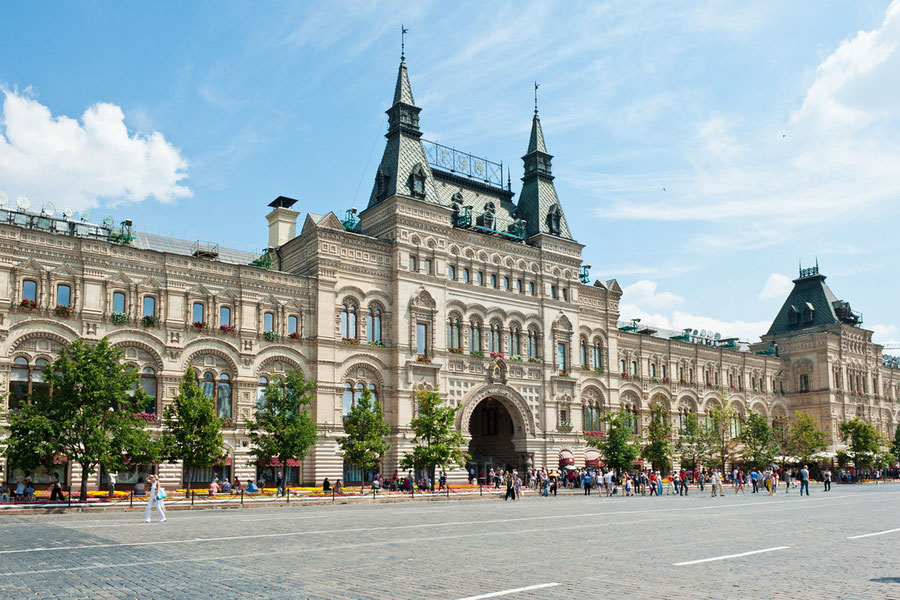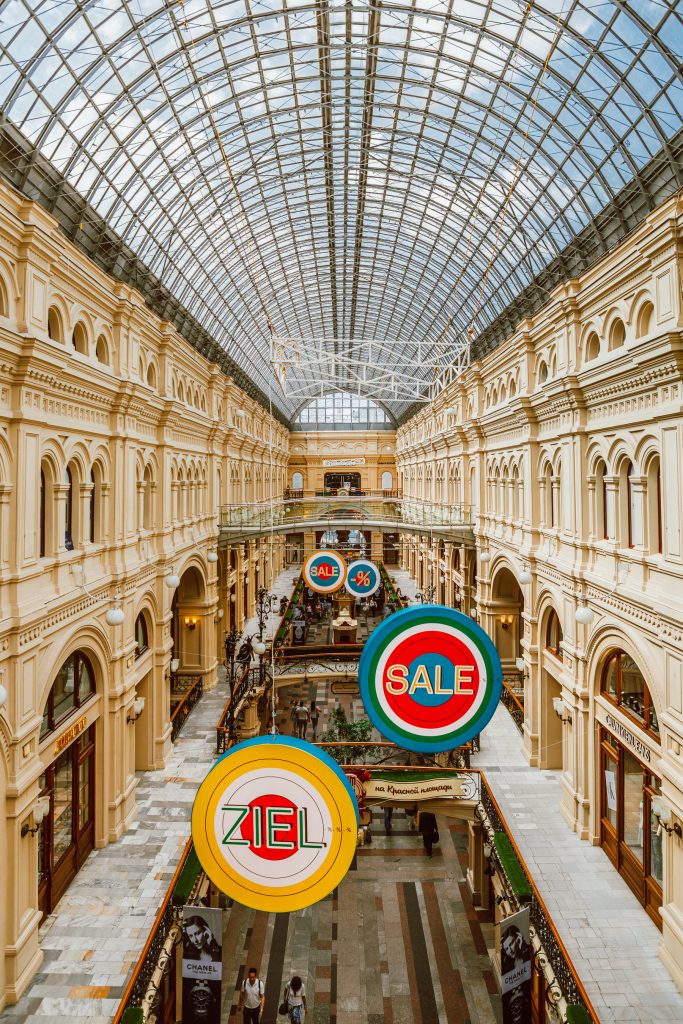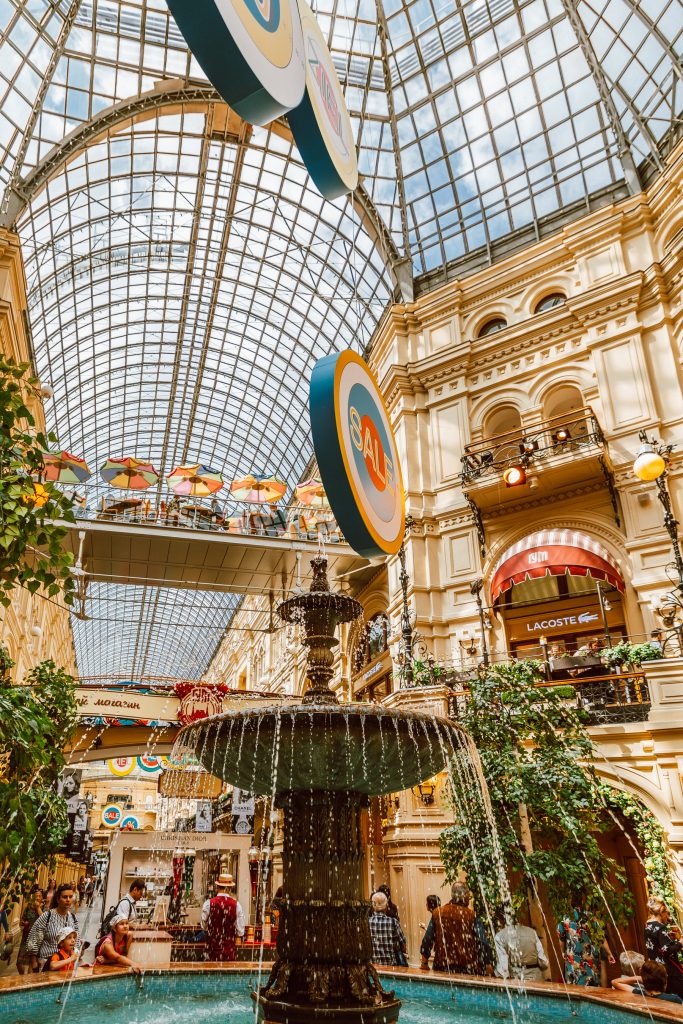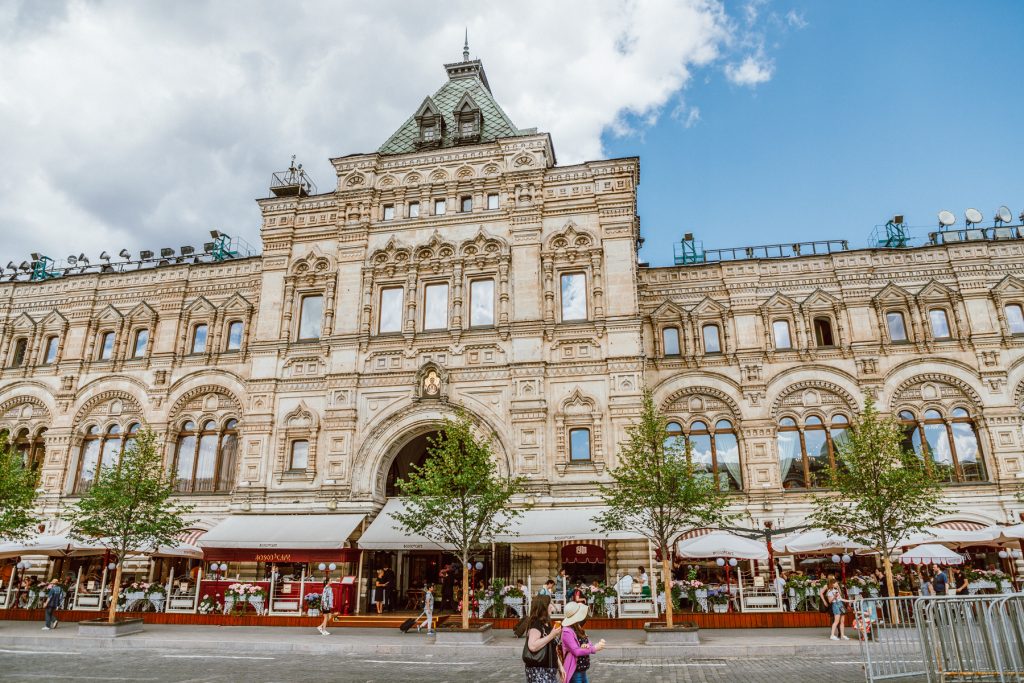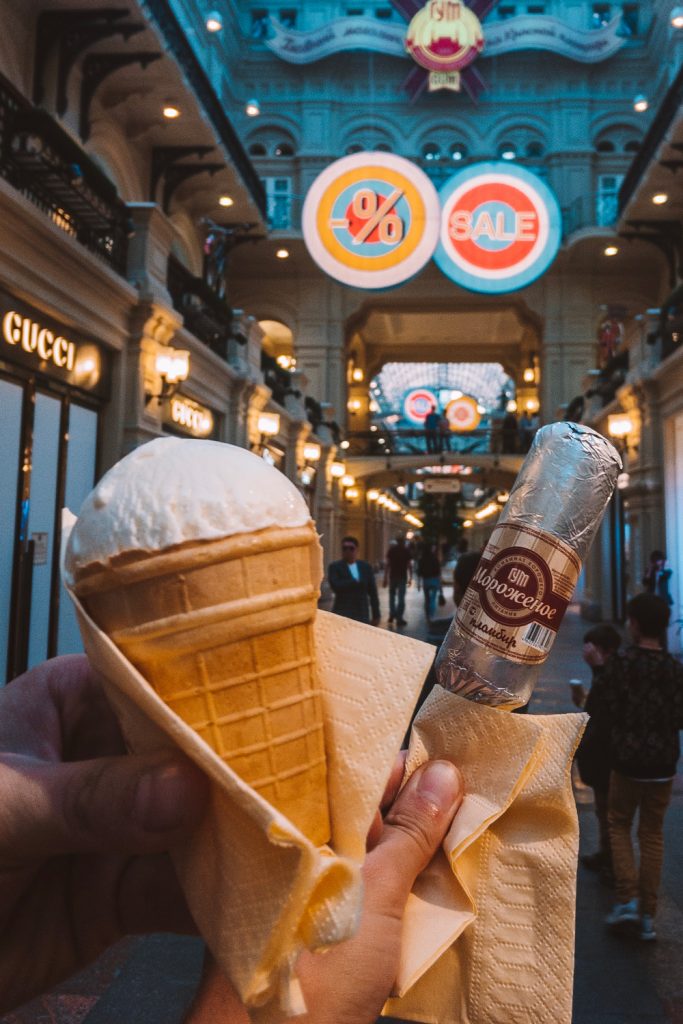

- Entertainment & Pop Culture
- Geography & Travel
- Health & Medicine
- Lifestyles & Social Issues
- Literature
- Philosophy & Religion
- Politics, Law & Government
- Science
- Sports & Recreation
- Technology
- Visual Arts
- World History
- On This Day in History
- Quizzes
- Podcasts
- Dictionary
- Biographies
- Summaries
- Top Questions
- Week In Review
- Infographics
- Demystified
- Lists
- #WTFact
- Companions
- Image Galleries
- Spotlight
- The Forum
- One Good Fact
- Entertainment & Pop Culture
- Geography & Travel
- Health & Medicine
- Lifestyles & Social Issues
- Literature
- Philosophy & Religion
- Politics, Law & Government
- Science
- Sports & Recreation
- Technology
- Visual Arts
- World History
- Britannica Explains
In these videos, Britannica explains a variety of topics and answers frequently asked questions. - Britannica Classics
Check out these retro videos from Encyclopedia Britannica’s archives. - #WTFact Videos
In #WTFact Britannica shares some of the most bizarre facts we can find. - This Time in History
In these videos, find out what happened this month (or any month!) in history. - Demystified Videos
In Demystified, Britannica has all the answers to your burning questions.
- Student Portal
Britannica is the ultimate student resource for key school subjects like history, government, literature, and more. - COVID-19 Portal
While this global health crisis continues to evolve, it can be useful to look to past pandemics to better understand how to respond today. - 100 Women
Britannica celebrates the centennial of the Nineteenth Amendment, highlighting suffragists and history-making politicians. - Britannica Beyond
We’ve created a new place where questions are at the center of learning. Go ahead. Ask. We won’t mind. - Saving Earth
Britannica Presents Earth’s To-Do List for the 21st Century. Learn about the major environmental problems facing our planet and what can be done about them! - SpaceNext50
Britannica presents SpaceNext50, From the race to the Moon to space stewardship, we explore a wide range of subjects that feed our curiosity about space!
- Home
- Russia
- Moscow
- Interesting places
- Trade centres
- GUM
GUM in Moscow, located in the heart of the city center, stands as witness to three different eras of Russian history, from the tsardom and the USSR to present-day Russia. GUM is an abbreviation for Gosudarstvenny Universalny Magazin (State Department Store). The shopping center was formerly known as the Upper Trade Rows but was renamed by decree of Lenin in 1921. GUM in Moscow is one of the largest shopping centers in all of Europe and Russia.
Moscow has long been Russia’s center for trade and finance. In times past, merchants from all across the nation would congregate in the capital to trade a wide range of goods in a frenzied yet calibrated fashion. The 1812 Fire of Moscow, believed to have been deliberately set by the Muscovites during the war with Napoleon, destroyed most of Moscow, including its shopping malls. The Upper Trade Rows, the forerunners of GUM Department Store which were located next to the Kremlin, were hastily erected by decree of Alexander I shortly after the fire.
The proud merchant class of Russia was ambitious, striving to keep pace with progress and open to the new innovations of capitalism. Eastern bazaars inspired Russians and Europeans to build covered shopping streets, which developed into department stores in the second half of the 19th century. The Moscow Department Store was built in this manner at the expense of the Merchants’ Guild of Moscow and opened in early December 1893 on the site of the former Upper Trade Rows.
Alexander Pomerantsev was the architect of GUM, and Vladimir Shukhov the engineer. At the time of construction, this commercial building was the largest in all of Europe and was the pride of Russian salesmen and merchants, offering the finest shopping in Moscow. GUM itself harmoniously blended with the Russian architecture near the Kremlin on Red Square, Moscow’s symbol of innovation and of a revitalized capital in burgeoning Russia.
GUM has been rebuilt and restored numerous times since its original construction. In 1921, in the heat of the period of New Economic Policy (NEP), sales rapidly increased at GUM, which became a proud symbol of its time. However, from 1930 to 1953 GUM was not used for its intended purpose, and instead the Moscow department store was occupied by various ministries, government departments and printing houses. It was only in 1953, during the Khrushchev Thaw, that GUM was restored to its historical purpose and its doors again opened to customers.
Today at GUM Moscow, brands from around the world are displayed in storefronts, and a wide array of high-end clothing, shoes, perfumes, jewelry, underwear, children’s goods and home supplies can be purchased here. It is a full-fledged shopping district that includes not only glamorous salons and shops, but also cafes, restaurants, bank branches and cinemas which attract more than 30 thousand visitors each day. In addition, GUM is a cultural center where art exhibitions, fashion shows and dynamic expositions are regularly held.
It should be noted that a short walk from GUM is TSUM, Moscow’s main Soviet-era department store that is often confused by visitors with GUM. Both shopping malls, while having developed through a unique history, are considered iconic landmarks in Moscow.
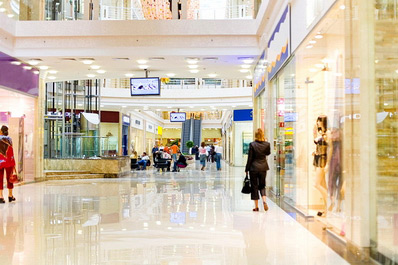 |
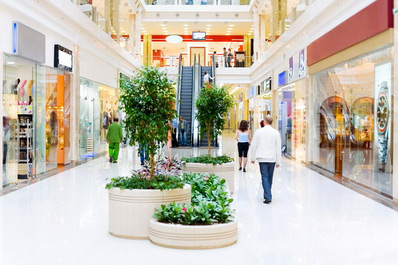 |
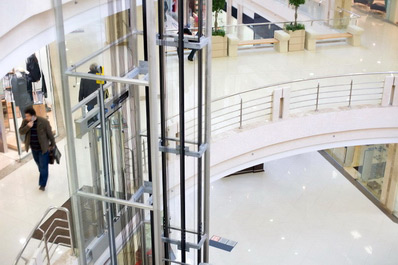 |
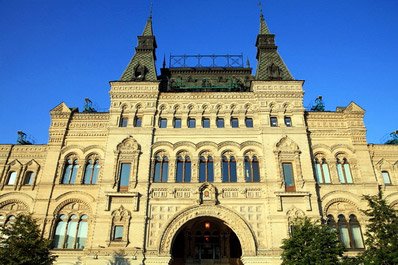 |
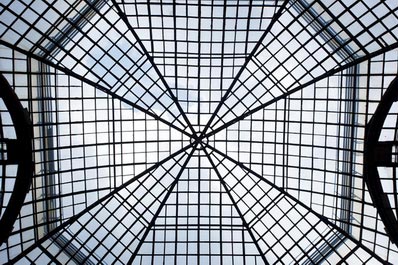 |
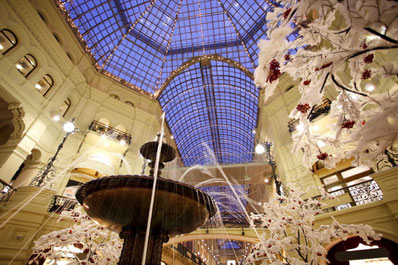 |
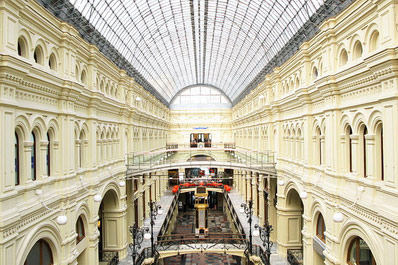 |
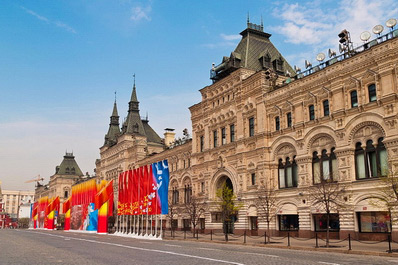 |
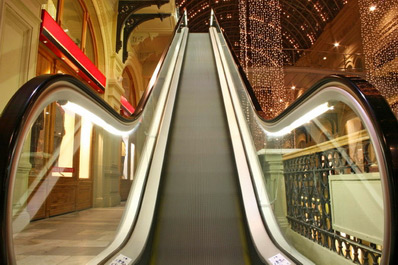 |
- Dates
- Categories
- Search
Please select a Date first.
Search for a company in Moscow
Moscow
Shopping Malls
The GUM shopping mall is a landmark in Moscow’s Red Square. It occupies the majority of the historic square’s east side with a facade stretching the length of two and a half football fields. The Gum (pronounced as ‘goom’) department store was built over a hundred years ago and is a testament to the expertise of late nineteenth century Russian architecture. With the looks of a royal palace this mall is a fitting addition to the numerous gems surrounding the Red Square.
The magnificent interiors comprise three elegantly designed floors with a glass roofed central courtyard spanning the whole length of the GUM. The floors are connected by bridges giving the whole area a graceful look associated with the finest buildings of yesteryear. At the centre of the complex is a lovely fountain that has served for decades both as a favourite meeting place and a popular photo opportunity.
Moscow’s GUM (each former soviet city had its own GUM) is today full of flagship stores with the most recognised brands from around the world. Apart from retail outlets, GUM also offers space for dining, cafes, exhibitions, galleries, leisure activities and cultural events.
Considering the beauty of this historic complex, the GUM in Moscow must be one of the most popular shopping malls in the country that doubles up as a great tourist attraction.
Opening Times
Monday — Sunday: 10am — 10pm
Mini Guides
Login to create your guides for Moscow.
Search, Compare, and Save up to 70%!
Return to the same location
Local Car Rental Comparison
with My Guide
Free cancellation
No need to worry if your plans change with free cancellation options available
24/7 Customer Service
All of our providers offer 24/7 support
500+ trusted car hire partners globally
Create & Share your own Guide to Moscow with friends and family!
Add your recommended places to visit by browsing the website and pressing the icon.
Create your own guide of favourite ‘must see’ places
Earn your Local Expert badge by Sharing your guides with others
Get your guide seen by submitting it to the Mini Guides section

Mini Guides
-
Must See Places For First Timers
Handpicked by a Local Expert
-
Best For Kids
Handpicked by a Local Expert
-
Places to watch the FIFA World Cup 2018
Handpicked by a Local Expert
From Wikipedia, the free encyclopedia
The GUM façade faces Red Square
Upper Trading Rows by night
GUM (Russian: ГУМ, pronounced [ˈɡum], an abbreviation of Russian: Главный универсальный магазин, romanized: Glavnyy universalnyy magazin, lit. ‘Main Universal Store‘) is the main department store in many cities of the former Soviet Union, known as State Department Store (Russian: Государственный универсальный магазин, romanized: Gosudarstvennyy universalnyy magazin) during the Soviet era (until 1991). Similarly named stores operated in some Soviet republics and in post-Soviet states.
The most famous GUM is the large store facing Red Square in the Kitai-gorod area – itself traditionally a mall of Moscow. Originally, and today again, the building functions as a shopping mall. During most of the Soviet period it was essentially a department store as there was one vendor: the Soviet State. Before the 1920s the location was known as the Upper Trading Rows (Russian: Верхние торговые ряды, romanized: Verkhniye Torgovyye Ryady).
As of 2021, GUM carries over 100 different brands,[1] and has cafes and restaurants[2] inside the mall.
Moscow GUM[edit]
Design and structure[edit]
With the façade extending for 242 m (794 ft) along the eastern side of Red Square, the Upper Trading Rows were built between 1890 and 1893 by Alexander Pomerantsev (responsible for architecture) and Vladimir Shukhov (responsible for engineering). The trapezoidal building features a combination of elements of Russian medieval architecture and a steel framework and glass roof, a similar style to the great 19th-century railway stations of London. William Craft Brumfield described the GUM building as «a tribute both to Shukhov’s design and to the technical proficiency of Russian architecture toward the end of the 19th century».[3]
The glass-roofed design made the building unique at the time of construction. The roof, the diameter of which is 14 m (46 ft), looks light, but it is a firm construction made of more than 50,000 metal pods (about 743 t (819 short tons)), capable of supporting snowfall accumulation. Illumination is provided by huge arched skylights of iron and glass, each weighing some 740 t (820 short tons) and containing in excess of 20,000 panes of glass. The facade is divided into several horizontal tiers, lined with red Finnish granite, Tarusa marble, and limestone. Each arcade is on three levels, linked by walkways of reinforced concrete.
History[edit]
Inside the store in 1893: elongated shop galleries are bridged with innovative metal-and-glass vaults, designed by Vladimir Shukhov
Inside view of the structure and finish applied to the building
Catherine II of Russia commissioned Giacomo Quarenghi, a Neoclassical architect from Italy, to design a huge trade area along the east side of Red Square. However, that building was lost to the 1812 Fire of Moscow and replaced by trading rows designed by Joseph Bove. In turn, the current structure opened in 1894, replacing Bove’s.[4]
By the time of the Russian Revolution of 1917, the building contained some 1,200 stores. After the Revolution, GUM was nationalized. During the NEP period (1921–28), however, GUM as a State Department Store operated as a model retail enterprise for consumers throughout Russia regardless of class, gender, and ethnicity. GUM’s stores were used to further Bolshevik goals of rebuilding private enterprise along socialist lines and «democratizing consumption for workers and peasants nationwide». In the end, GUM’s efforts to build communism through consumerism were unsuccessful and arguably «only succeeded in alienating consumers from state stores and instituting a culture of complaint and entitlement».[5]
GUM continued to be used as a department store until Joseph Stalin converted it into office space in 1928 for the committee in charge of his first Five Year Plan.[4] After the suicide of Stalin’s wife Nadezhda in 1932, the GUM was used briefly to display her body.[6]
After reopening as a department store in 1953, GUM became one of the few stores in the Soviet Union that did not have shortages of consumer goods, and the queues of shoppers were long, often extending entirely across Red Square.[7]
Several times during the 1960s and 1970s, the Second Secretary of the Communist Party Mikhail Suslov, who hated having a department store facing Lenin’s Mausoleum, tried to convert GUM into an exhibition hall and museum showcasing the achievements of the Soviet Union and Communism, without the knowledge of General Secretary Leonid Brezhnev. Each time, however, Brezhnev was tipped off and put a stop to such plans.[8]
At the end of the Soviet era, GUM was partially, then fully, privatized, and it had a number of owners before it ended up being owned by the supermarket company Perekrestok. In May 2005, a 50.25% interest was sold to Bosco di Ciliegi, a Russian luxury goods distributor and boutique operator. As a private shopping mall, it was renamed in such a fashion that it could maintain its old acronym. The first word Gosudarstvennyi («state») has been replaced with Glavnyi («main»), so that GUM is now an abbreviation for «Main Universal Store».
See also[edit]
- TsUM, another large Moscow department store.
- Passage, a department store in St. Petersburg.
References[edit]
- ^ «All stores of GUM». gumrussia.com. Retrieved 2020-10-14.
- ^ «Cafes and restaurants in the main department of the country». gumrussia.com. Retrieved 2020-10-14.
- ^ Brumfield, William Craft (1991). The Origins of Modernism in Russian Architecture. Berkeley, Los Angeles, Oxford: University of California Press. ISBN 0-520-06929-3.
- ^ a b Pomeratzev, Alexander. Верхние торговые ряды на Красной площади в Москве. 1890–1893 (in Russian). Russian Educational Portal. Archived from the original on 4 March 2016. Retrieved 20 April 2013.
- ^ Hilton, Marjorie L. (2004). «Retailing the Revolution: The State Department Store (GUM) and Soviet Society in the 1920s». Journal of Social History. Oxford University Press. 37 (4): 939–964, 1127. doi:10.1353/jsh.2004.0049. ISSN 0022-4529. S2CID 144010294.
- ^ Kolesnik, Alexander. «Chronicles of Stalin’s family» (in Russian). Librusek. Retrieved 20 April 2013.
- ^ «History of GUM» (in Russian). Official GUM website. Retrieved 20 April 2013.
- ^ Thelman, Joseph (December 2012). «The Man in Galoshes». Jew Observer. Retrieved 28 February 2021.
{{cite web}}: CS1 maint: url-status (link)
Sources[edit]
- Brumfield, William Craft, (1991) The Origins of Modernism in Russian Architecture, University of California Press, Berkeley, Los Angeles, Oxford, ISBN 0-520-06929-3
- English, Elizabeth Cooper (2000). «Arkhitektura i mnimosti»: The origins of Soviet avant-garde rationalist architecture in the Russian mystical-philosophical and mathematical intellectual tradition», a dissertation in architecture, University of Pennsylvania
- Hilton, Marjorie L. (2004). «Retailing the Revolution: The State Department Store (GUM) and Soviet Society in the 1920s». Journal of Social History, (Oxford University Press) 37 (4): 939–964; 1127. ISSN 0022-4529
- Rainer Graefe, Jos Tomlow: «Vladimir G. Suchov 1853–1939. Die Kunst der sparsamen Konstruktion.» 192 S., Deutsche Verlags-Anstalt, Stuttgart, 1990, ISBN 3-421-02984-9
External links[edit]
Wikimedia Commons has media related to Moscow GUM.
- GUM official website
- GUM at Structurae
- Vladimir Grigorievich Shukhov
- The Roof of GUM
Coordinates: 55°45′17″N 37°37′17″E / 55.75472°N 37.62139°E
Set in the heart of Moscow, the majestic GUM (goom) is a gorgeous sight of epic proportions, grandeur beyond words, and extraordinary lavishness. The Gosudarstvenny Universalny Magazin, or State Department Store, was built between 1890 and 1893 to replace the incinerated trading rows of 1825.
The entire structure is a gorgeous testament to Russian architecture with its mix of medieval-inspired buttresses and modern steel fixtures. The glass roof allows natural light to flood this three-story palace of a mall, paying homage to old London train stations.
The façade is composed of stunning red granite, marble, and limestone, stretching for 794 ft along Red Square’s eastern side. Concrete walkways connect the three levels of the arcade inside.
Gum Department Store Moscow
GUM has been many things during Moscow’s history. Before the revolution of 1917, it contained 1200 stores of various fashions and trinkets. Stalin converted this magnificent building into offices in 1928, and in 1932 it became a somber display for the body of Stalin’s second wife.
It did not reopen as a department store until 1953, and after the collapse of the Soviet Union, it passed through numerous private owners. In 2005 it was bought by a supermarket chain, and since then, it has been one of Moscow’s main tourist attractions.
There is a similar historic department store in Moscow that rivals GUM in size, elegance, and opulent architecture. It is the Central Universal Store (Tsentralniy Universalniy Magazin, abbreviated as TsUM) that sprawls just east of the Bolshoi Theater.

XIX century
The Upper Trading Rows were opened on December 2nd 1893. Exceptional for Moscow and Russia project became the largest passage in Europe at the time. Passages — covered shopping streets – were invented at the beginning of the XIX century in Paris after the Napoleonic wars, inspired by the covered bazaars of the Arab Countries.
The oldest one, Passage du Caire, was built in 1799. But these were just covered shopping streets which became stores in the second half of the century. GUM’s closest analogue is Galleria Vittorio Emanuele II in Milan (1877), but the Moscow’s passage is half as much. Also the passage in Milan has no stores at the upper levels
due to the lack of bridges, which GUM is proud of.
The Upper Trading Rows were deliberately created as a symbol of the New Moscow.
They were built in the traditional Moscow market place featuring endless shops of various sizes and ranks.
Although classic facade designed by Osip Bove faced the Red Square,
the Rows were vividly reminiscent of the Grand Bazaar in Istanbul or Damascus inside.
After the reforms carried out by Alexander II, Moscow was the place of proud Russian merchants,
oddly combining fervent conservatism in the spirit of «autocracy, orthodoxy & nationality» and openness
to technical progress and new ideas of capitalism. The new Rows should have become the
most fashionable and technologically advanced European department store in «Russian style».

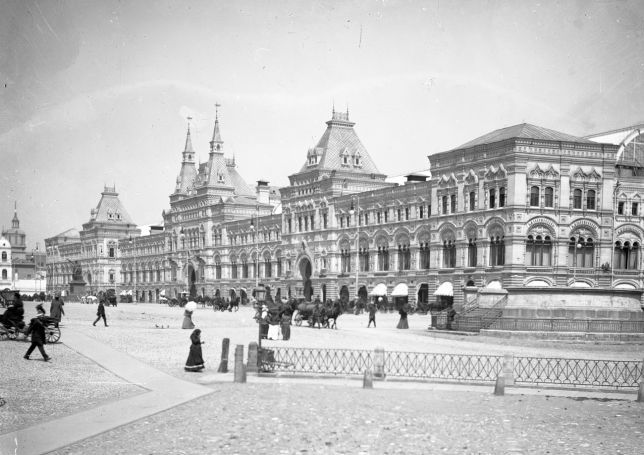
A competition for the project of the Trading Rows held in February 1889 was won by Alexander Pomerantsev.
Roman Klein, who got the second place, built the Middle Trading Rows later. It sounds fantastic now,
but just in 4 years — after the condemnation of the old rows, after the archaeological dig and findings’
handling to the Historical Museum — the Rows have been opened. With full finish, with Vladimir Shukhov’s
glass heaven, with its own power plant & artesian well, with wholesale trade in the basement, with the
offices of telegraph & bank, restaurants, hairdressers, exhibition halls & studios but without its own doors.
According to the original project of Alexander Pomerantsev, the Upper Trading Rows represented
16 large individual buildings with glazed streets between them. It was a city, a perfect city of
Russian merchant capitalism offering silk and brocade fabrics from Sapozhnikov brothers
(6 Grand Prix at the World Exhibition), Mikhail Kalashnikov watches (Leo Tolstoy & Pyotr Tchaikovsky
bought Patek Philippe watches in his shop), pastry of Abrikosovs (suppliers of the Imperial Court
with the right to print the national emblem on the boxes), Brocard perfumery
(another supplier of the Imperial Court as well as the official supplier of the Spanish royal court),
and so on. However, the upper levels & lines featured cheaper products and huge two-level basement,
illuminated through the glass lights in the floor, was used for the wholesale trade.
XX century
In 1917, the trade was terminated and goods were confiscated.
People’s Food Commissariat of Alexander Tsiuriupa, which carried out the policy of «food dictatorship”,
was located here. The Rows also hosted the warehouse of requisitioned items and Soviet workers’ dining-room.
«In 1922, Vladimir Lenin decided that «»war communism»» policy would not let the Communists
to be in power and proclaimed the idea of a «»long-term coexistence of capitalism and communism»».
He began to restore diplomatic relations with the West and announced the NEP — «»New Economic Policy»».
But he decided to start from the Upper Trading Rows and signed the «»Regulations on
the State Department Store (GUM)»» on December 1st, 1921.
We do not feel special taste of this word, it has become customary for us,
and yet it is one of the few words of the 20s that Russian language has since then. It is like RKKA
(Red Army), GUKON (State Horse-Breeding Administration) or Rabkrin (Workers’ and Peasants’ Inspectorate).
All of them except GUM disappeared as useless. GUM advertising along with Vladimir Mayakovsky a
nd Alexander Rodchenko posters filled Moscow streets. GUM has become a symbol of the New Economic Policy.
»
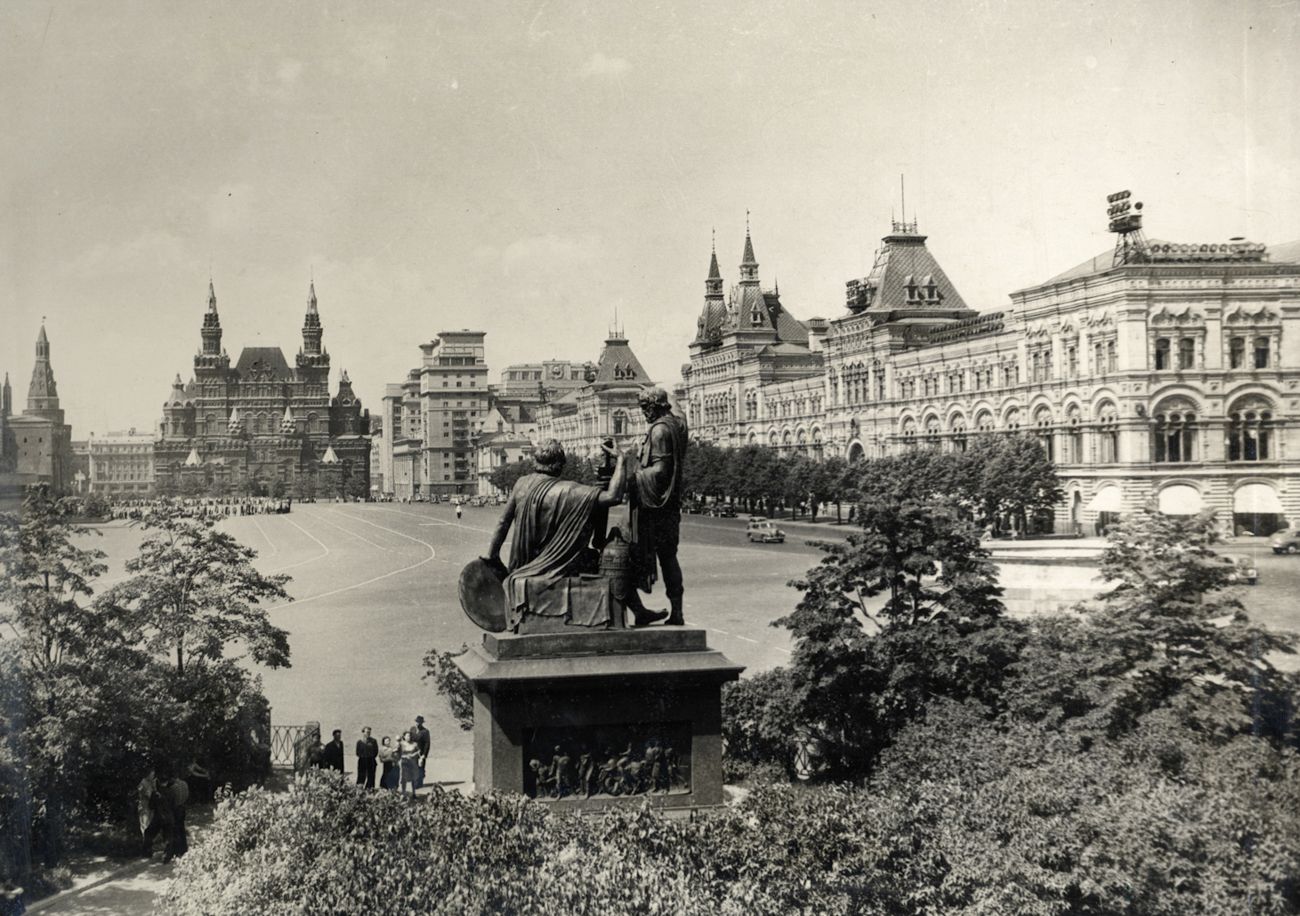
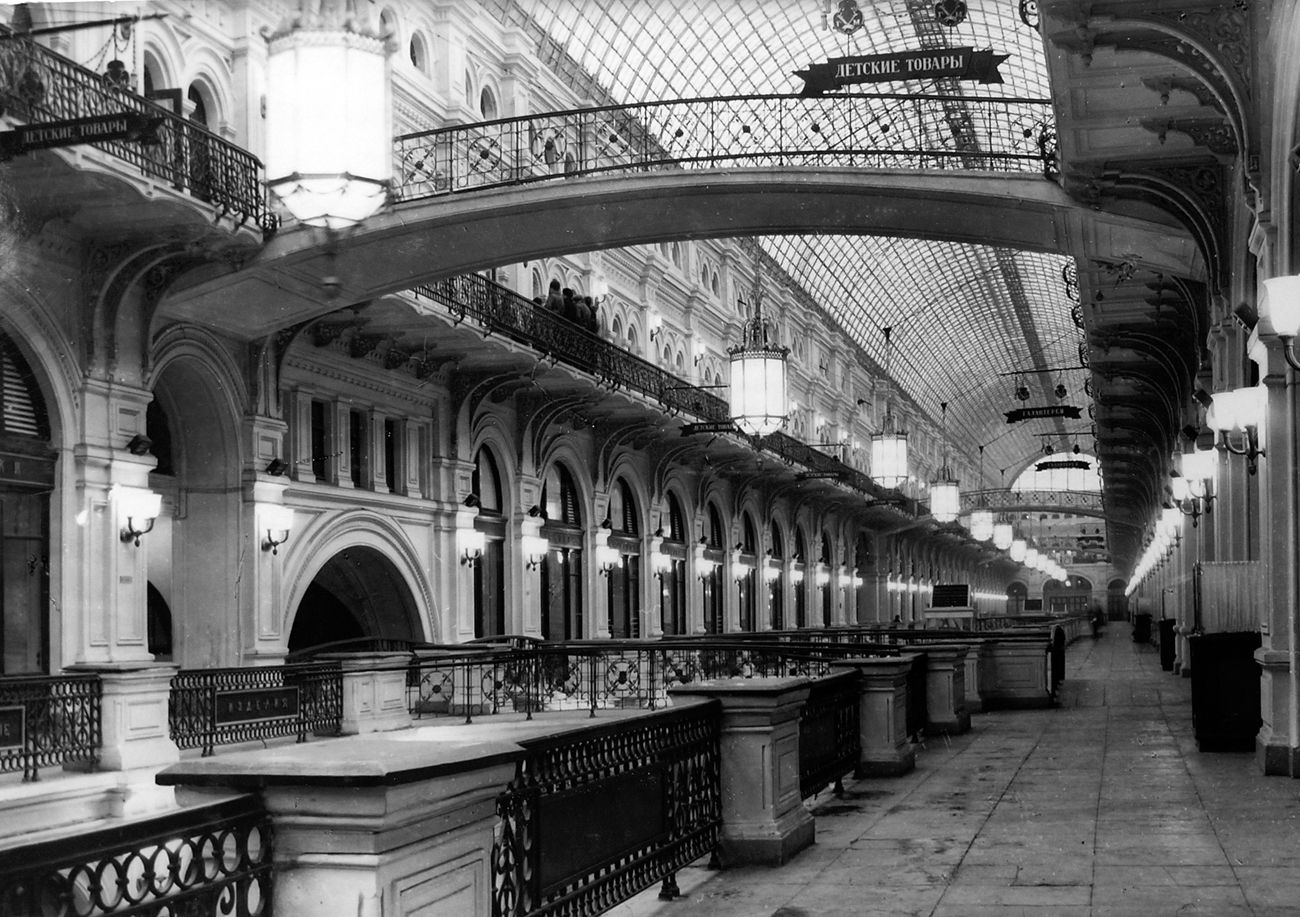
Stalin closed GUM in 1930. Ministries and departments moved here.
The first line was completely closed as Beria’s office was located there.
There was a kind of trading. Torgsin (Trade with foreigners shops) & commission shops
selling property of peoples’ enemies worked near the fountain. There also was a grocery
store facing Nikolskaya Street, but in general, GUM ceased to exist. Stalin was going to
demolish it twice (in 1935 and in 1947), government regulations were issued twice, but he did not get round.
Stalin died on March 5th, 1953. His successor Georgi Malenkov declared that
Stalin have commanded to keep peace between the peoples and put forward the idea of
long-term coexistence of the two systems and international tension decreasing.
The military budget was reduced by half, intensive development of agriculture
and light industry was started. It all became known as Khrushchev Thaw later.
But again they decided to try it in GUM first. It was renovated and opened to the
public on December 24th, 1953. Lavrenti Beria was shot on December 23rd.
Newspapers wrote about these events on the identical day. GUM became a symbol of the thaw.
GUM has a unique destiny. It was opened when Russia turned towards people,
common city life and even happiness. Fashion in GUM, demonstration hall, disks &
records in GUM, GUM ice cream are the symbols of Moscow. And it all varnished when the country reversed.

GUM today
«Today GUM lives like it once was conceived.
It is ideal shopping city of Moscow that seems to live without losses and catastrophes for 120 years already.
The fountain in the center of GUM was reopened and pleases visitors since 2007.
This legendary construction is captured in the official chronicles of the twentieth
century and in millions of private shots. They say, the sound of a shutter can be heard
every three seconds here today. The legendary cinema, which went down in the history
of the national movie-making, was restored. Unique illumination project was carried out on the facade.
GUM-Skating rink was opened at Red Square in 2006, which at once gained the fame of
the brightest ice rink of the capital. We have revived the tradition of winter festivities at
Red Square that were popular in Moscow in the XIX century, and added the lightest and happiest
traditions of the XX centuries to them.»
«The Gastronome N1, which once was created by Anastas Mikoyan as practical
application to his «»Book of tasty and healthy food»» is reopened in GUM.
Interior design, sellers’ clothing and even the range of some classic Soviet goods
(for example, «»Three elephants»» tea) takes us back to the 50-60s of the last century
although it is the game of course. At bottom, it meets gastronomic caprices of the most
exigent modern consumer. The cafe Festivalnoye and Stolovaya No 57are also made in the
same Soviet style. The cafe is named in honor of the Festival of Youth and Students held
in Moscow in 1957 that brought together 34 000 people from 131 countries.
Drawings & slogans in several languages placed on the walls remind about this event.
The Stolovaya No 57 is classic self-service line.
Mikoyan saw this idea in America in 1936 but could implement it in the Thaw Era only.
However, the food is different here now. It offers good Russian and European cuisine,
but not «»hamburgers»» as Mikoyan used to call it or «»Mikoyan’s patties»» as Soviet people
used to call it in their turn.»
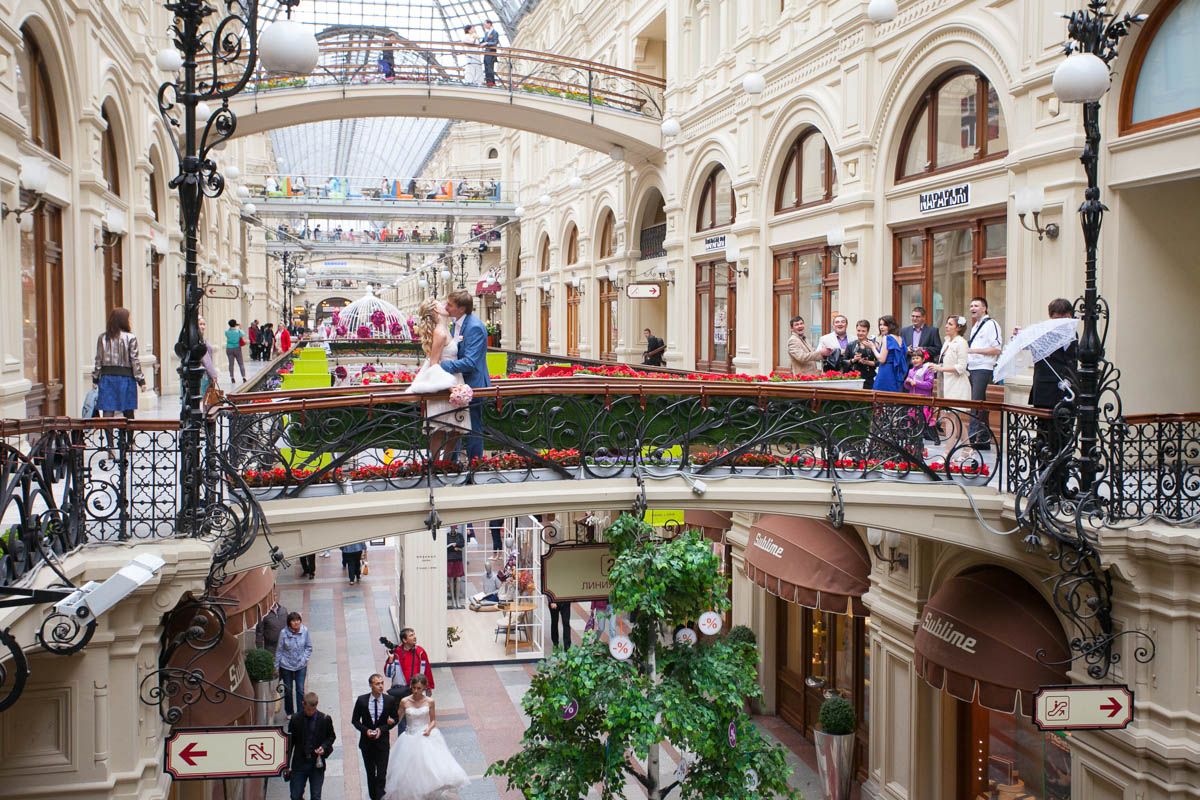
«GUM is not just a store where you can buy almost everything.
It is a shopping block where there is a pharmacy, bank branch, and flower shop …
It is a monument of architecture. It is a comfortable lounge area with restaurants and cafes.
It is an art gallery and venue for cultural events. It is an integral part of Russian history.
It is a symbol of Moscow and it is the closest place to the Kremlin, where you can feel yourself in Europe.»
GUM is a famous department store located in the very heart of Moscow, Russia. This mall have gone through many historical periods and have seen Imperial Russia, Soviet Union and modern Russia. For more than 100 years it has been serving people from all over the world. When was GUM built? What to do in GUM? What shops can you find there? Why GUM Moscow ice cream is so famous? Let’s find out answers to these questions and discover 10 facts about GUM.
Want to know more about Moscow? Planning your visit to the capital city of Russia?
Check more articles about Moscow on our blog.
The glass-roof was engineered by Vladimir Shukhov. Its design made the building unique at the time of construction Fountain is the most popular place in GUM. People always say: let’s meet near the fountain
10 INTERESTING FACTS ABOUT GUM MOSCOW
1. GUM is located on Red Square in Moscow
Red Square is the most popular tourist destination in Moscow and in Russia (explore our list of 15 places you need to see on the Red Square). It’s hard to imagine a better location for a department store than right opposite the Kremlin. Such an amazing spot for this mall was a problem a couple of times in the past though. In Soviet period, there were talks of replacing GUM with a high-scraper, the Pantheon or other building but luckily they never came true.
2. Pronounced in Russian as Glávnyj Universáľnyj Magazín
As many of you know, Russia uses the Cyrillic alphabet, so actually in Russian GUM is written as ГУМ – Главный Универсальный Магазин. This literally means Main Universal Store. In Soviet union, the same abbreviation was used but it meant State Department Store. In Russian, both words start with the same letter: Glavniy and Gosudarstvenniy. Even now lots of people still call it by its former name.
3. The first building was constructed in the 18th century and was lost during the war with Napoleon
This area (which is called Kitai-Gorod and can be translated as China Town) historically was always a place for trading. Years has passed, city has grown, but people were very much used to coming here for shopping. So in the 18th century, Catherine II hired Italian architect Giacomo Quarenghi to design a huge trade centre on the Red Square. During the war with Napoleon, this first building was lost in 1812 Fire of Moscow. Joseph Bove, who was working on restoring Moscow city centre after this fire, created design of the new trading rows on the same place. But it still wasn’t the building we can see now.
4. The current building was opened to the public in 1893
The current GUM Moscow building replaced Bove’s structure and was opened to the public in 1893. It was a very modern design: elongated shop galleries were bridged with innovative metal-and-glass vaults, designed by Vladimir Shukhov. Even more than hundred years later, the interior of GUM and its construction look very impressive.
5. GUM Moscow is built in Russian Revival style
Also known as Pseudo-Russian style or Neo-Russian style, Russian Revival style was a very popular trend in architecture in the 19th century. It is an eclectic mix of pre-Petrine Russian architecture and elements of Byzantine style. State Historical Museum located next to GUM was built slightly earlier in the same style, so these two landmarks create an amazing ensemble together.
6. In the 1950s, queues of shoppers were extending entirely across Red Square
Due to shortage of consumer goods in the Soviet Union, GUM was one of few places where people were able to get produce. Stock was extremely limited but locals had no choice, the country was slowly recovering after the World War II. In the 1950s, it was usual to see queues of shoppers extending across the Red Square and spending days to get inside.
7. Over 100 world-famous brands are presented in GUM Moscow
In post-Soviet era, GUM became a spot for luxury shopping. You can find the most expensive and exclusive brands here including Cartier, Gucci, Luis Vuittton, Burberry, Chanel, Hermes, Bulgari, Prada and others. There is also a soviet-style grocery shop, food court, cafes, restaurants and even a historical toilet.
8. Famous ice-cream is sold in GUM
GUM Moscow ice cream is one of the most famous snack/dessert of locals and tourists. This is a traditional Soviet ice cream made from old recipe. There are several options, but the traditional is vanilla ice cream scoop in a scone. It may sound simple but you can only judge after trying it because it’s DELICIOUS. It’s sold from a small stall on the ground floor. It’s also reasonably cheap.
9. GUM fountain is a well-known meeting place
GUM is a beautiful building with amazing interior design and one of the most beloved spots inside is the fountain plaza. The fountain is amazing and people love taking pictures with it. There is also a couple of stalls located around where you can buy Soviet-style soft drinks (GUM really tries to preserve the Soviet heritage). Great views to GUM fountain also open from upper levels and from the food court. The fountain is a well-known meeting place for locals and tourists as it can be seen from almost everywhere inside the department store.
10. GUM has a rival historic department store called TsUM
There is a similar historic department store TsUM that rivals GUM in size, elegance, and opulent architecture. TsUM is located near the Bolshoi Theatre (around 5 minutes walk from GUM). TsUM is the largest fashion department store in Eastern Europe with seven levels. Even though TsUM is located in old building (1908), its interiors were refurbished multiple times, so it has feeling of a modern mall. Like GUM, TsUM sells luxury goods, but there are corners not a separate boutiques inside.
Did you know any of these facts? Want more articles like this? Reach out to us on Instagram and tell us what you are interested in.
More information about GUM can be found on its official website. Available in English, Russian and Chinese.
Love visual content? We have lots of videos about Moscow, Russia as well as other travel videos
on our YouTube channel.

